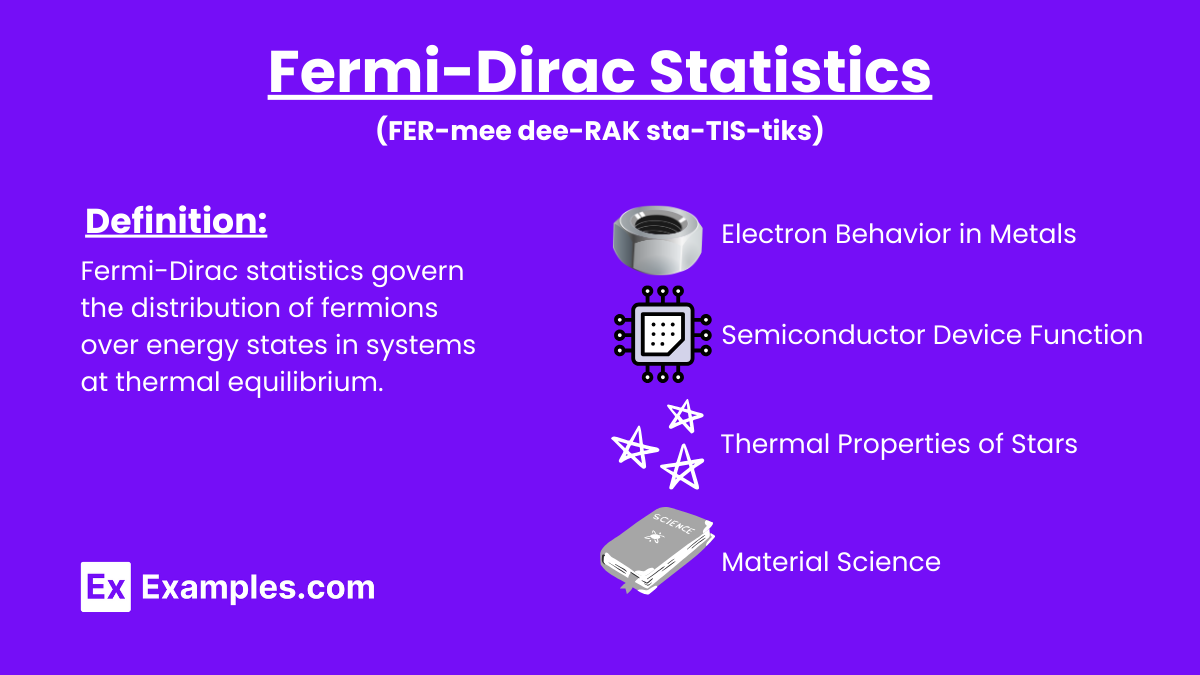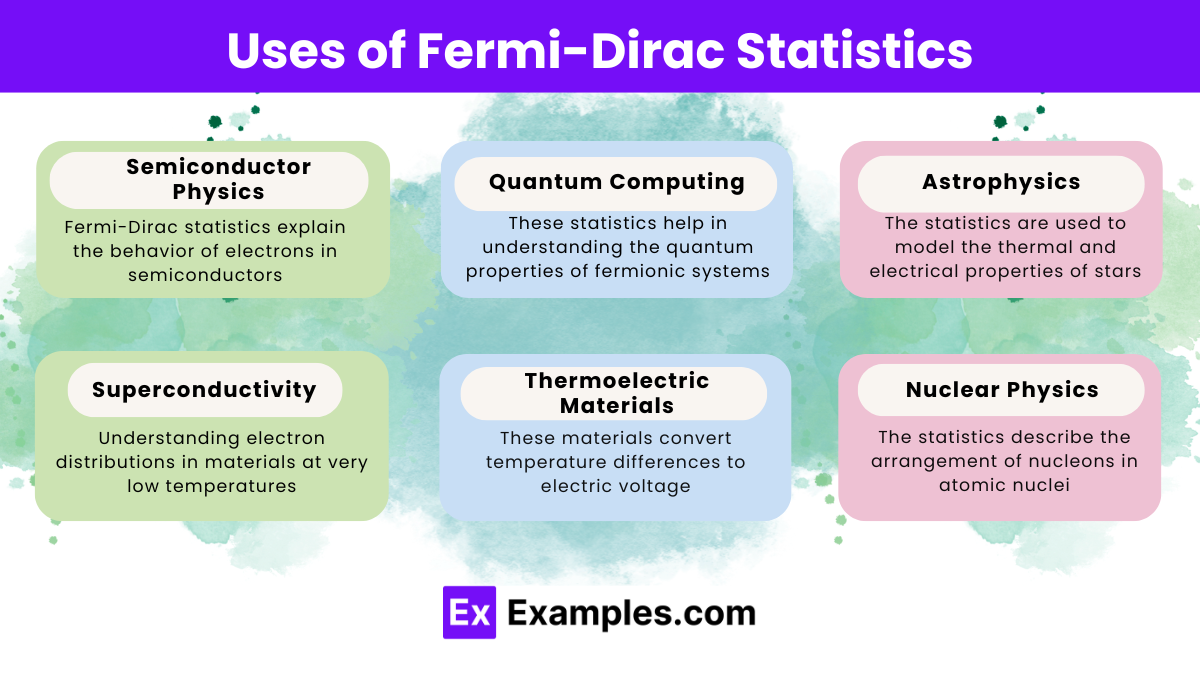What does Fermi-Dirac statistics describe?
The behavior of photons in a gas
The distribution of electrons in a metal
The movement of gas molecules in a container
The rate of chemical reactions


Fermi-Dirac statistics govern the distribution of fermions over energy states in systems at thermal equilibrium. Fermions are particles that adhere to the Pauli exclusion principle, which states that no two identical fermions can occupy the same quantum state simultaneously. This principle is a cornerstone in the laws of physics, particularly quantum mechanics. Enrico Fermi and Paul Dirac developed these statistics independently in the early 20th century.
The formula for Fermi-Dirac statistics is crucial for understanding how fermions such as electrons, protons, and neutrons distribute themselves across energy states in a quantum system at thermal equilibrium. The formula reflects the probability that a given energy state at energy E is occupied by a fermion. This probability, denoted as 𝑓(𝐸), is expressed by:
Here:
The derivation of Fermi-Dirac statistics can be summarized in a few key steps, focusing on the statistical behavior of fermions—particles like electrons that follow the Pauli Exclusion Principle.
Begin by considering a system of fermions which are indistinguishable and obey the Pauli Exclusion Principle. This principle dictates that no two identical fermions can occupy the same quantum state simultaneously.
For each quantum state, a fermion has two possible choices: to occupy the state or not. This binary possibility leads to the concept of occupation number, which can be either 0 or 1 for each state in a fermion system.
Assume the system is at thermal equilibrium. The probability of a state being occupied depends on its energy. Use the Boltzmann factor from classical statistical mechanics as a starting point, modified to respect the exclusion principle.
Introduce the chemical potential 𝜇, which adjusts for the number of particles and energy. The chemical potential is essential in ensuring that the total number of particles is conserved in the equilibrium state.
Combine these elements into the Fermi-Dirac distribution:
𝑓(𝐸)=1/𝑒^(𝐸−𝜇)/(𝑘𝑇)+1
Here, 𝐸 is the energy of the state, 𝑘 is the Boltzmann constant, and 𝑇 is the temperature. The distribution describes the probability that a quantum state at energy 𝐸 is occupied by a fermion.

Fermi-Dirac statistics are essential for understanding the behavior of fermions, which are particles with half-integer spin subject to the Pauli Exclusion Principle. Here are some of the key applications of these statistics:
Enrico Fermi and Paul Dirac developed these statistics independently in the early 20th century.
They explain properties of systems containing fermions like electrons and protons, crucial in solid-state physics and quantum mechanics.
Fermi-Dirac applies to fermions, which obey the exclusion principle; Bose-Einstein applies to bosons, which do not.
It states that no two identical fermions can occupy the same quantum state simultaneously.
A fermion is a particle with half-integer spin that follows Fermi-Dirac statistics, such as electrons and quarks.
They help predict electron distribution among energy levels, influencing electrical and thermal conductivity.
The Fermi energy is the highest energy level occupied by fermions at absolute zero temperature.
They predict electron behaviors in semiconductors, essential for designing electronic devices.
Yes, they are used to calculate specific heat and thermal properties of electron systems at low temperatures.
The Fermi surface represents the collection of points in momentum space where the energy of particles equals the Fermi energy.
Text prompt
Add Tone
10 Examples of Public speaking
20 Examples of Gas lighting
What does Fermi-Dirac statistics describe?
The behavior of photons in a gas
The distribution of electrons in a metal
The movement of gas molecules in a container
The rate of chemical reactions
Which principle is fundamental to Fermi-Dirac statistics?
The Principle of Relativity
The Pauli Exclusion Principle
The Law of Universal Gravitation
The Law of Conservation of Mass
In Fermi-Dirac statistics, what does the term "Fermi energy" refer to?
The average energy of all particles in the system
The energy required to ionize a particle
The maximum energy of electrons at absolute zero temperature
The minimum energy of particles in the system
How does the distribution function for Fermi-Dirac statistics differ from that for Bose-Einstein statistics?
It allows for multiple particles to occupy the same state
It is only applicable to bosons
It restricts multiple particles from occupying the same state
It describes the distribution of photons
What happens to the Fermi-Dirac distribution function at absolute zero?
All energy levels are equally populated
Only the lowest energy states are filled
All states are empty
The distribution becomes uniform
Which equation describes the Fermi-Dirac distribution function?
Maxwell-Boltzmann distribution
Bose-Einstein distribution
Fermi-Dirac distribution function
Planck's law
What is the impact of temperature on the Fermi-Dirac distribution?
Temperature has no effect
As temperature increases, more high-energy states become occupied
Temperature only affects the Fermi energy
Temperature decreases the total number of particles
In a degenerate Fermi gas, how does the density of states behave?
It decreases with energy
It is constant across all energies
It increases with energy
It is independent of energy
What role does the Fermi level play in solid-state physics?
It determines the highest occupied electron energy level at absolute zero
It is the energy required to remove an electron from an atom
It sets the temperature of the solid
It describes the crystal structure of the material
How does Fermi-Dirac statistics apply to a system of electrons in a metal?
It provides the average energy of electrons
It determines the distribution of electrons among available energy states
It calculates the rate of electron flow
It describes the magnetic properties of the metal
Before you leave, take our quick quiz to enhance your learning!

